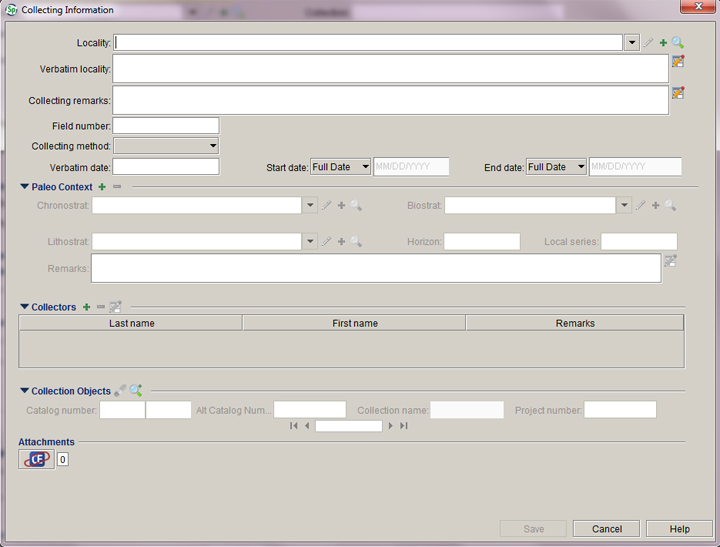Specify Quick Guide - Collecting Event Subform
This document is meant to be a quick reference for volunteers doing inventory and basic data entry. For a complete guide to Specify, please refer to either the NPL Specify guide or the Specify website.
The Collecting Event Subform
All Collection Objects were collected at a particular time and place. This subform allows you to to enter all the collecting data for your collection objects. Multiple Collection Objects may be collected during the same collecting event, therefore a single collecting event may be connected to many collection objects. When editing a Collecting Event, any changes you make will affect the Collection Objects that are associated with that event.

Locality
This the specific locality name we give to a specific place that can be found on a map. The Locality field is a lookup table. You can begin typing your locality name, and hit the "Tab" key to bring up existing records. If there is no record that exactly corresponds to the locality you need, you may add a new locality by clicking on the create locality button to the right of the locality field (plus sign). It is always better to add a new locality than to use a an existing locality that isn't quite what you are looking for.
If you do select an existing locality, you can look at its complete locality information by clicking the edit button (pencil). DO NOT make changes to the locality. If the locality doesn't fit the one you are trying to use, then make a new one. Locality Subform coming soon
see How to Write a Locality Name
Verbatim Locality
This is EXACTLY how the locality info is written on the label. Always enter ALL of the verbatim info here.
Examples of Verbatim locality:
Verbatim |
Locality Field |
??, Ill. |
unknown locality, IL |
illegible label |
unknown locality |
If you can only read a part of the label, you can add your own information in square brackets [ ]
Verbatim |
Locality Field |
[illegible] River, Travis Co., TX |
unknown locality, Travis Co |
Field Number
Every Collecting Event now must have a field number. Sometimes the collector provides the number, but when we aren't given a number, we have to create one. Click here for complete details
As a general rule, a field number contains up to four parts with dashes in between (ZACH = Lou Zachos):
NPL-000001 (if you have a locality, but no collecting info)
ZACH-NPL-0001 (you have a collector, but no other collecting info)
ZACH-NPL-date-01 (you have a collector and a date)
ZACH-NPL-localityNumber-01 (you have a collector, and a locality number)
ZACH-NPL-date-localityNumber-01 (you have a collector, date and a locality number)
If the collector does provide field numbers, then write the field number:
ZACH-field number (in whatever format you are given)
Use these standards:
1. Use first four letters in the main collectors last name in all-caps.
2. NPL - to indicate that this is not a collectors own field number, but one we generated ourselves.
3. Date, if you have one, should be written full year/month/day with the month written using the first three letters. Ex: June 20, 2014 = 2014Jun20
4. incremental numbers (01, 02, 03, etc) if needed
Collecting Method
If you know the collecting method, choose from the drop down list.
Verbatim Date
Enter exactly how the Collector wrote the date. Examples: "1/1/2001" or "22 May 2013" or "May-Dec 1998"
Start Date and End Date
Enter the collecting dates here. Start date and end date are often the same day.
Collecting Remarks
Any other remarks about the event that were not part of the Verbatim Locality. Examples include: "donated by Liath Appleton" or "starfish, urchins and barnacles collected" or "1995 field trip."
Paleo Context
What geologic time frame is represented by this object?
Collectors
Enter all collectors individually.